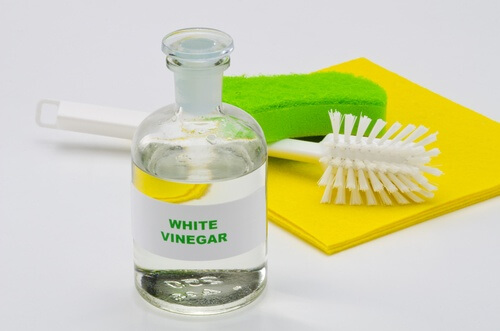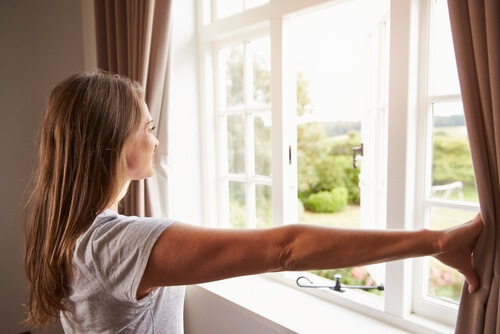6 Things You Can Do To Improve the Air Quality in Your Home

To have a healthy and balanced house, it’s important to keep in mind that there are methods for cleansing the air you breathe. That’s why it’s very important to improve the air quality.
You might not see it at a glance. However, its normal for air to be contaminated by chemical products, particles from the environment and dust.
In fact, this is one of the main causes of allergies and respiratory problems. The most troubling thing is that many people completely ignore it.
As a result, today we want to share 6 easy recommendations that let you improve your air quality. This way, you can do this before you create bad energy or health problems.
Put them to use!
1. Use environmentally-friendly cleaning products

We’ve gotten used to so many industrial cleaning solutions that we’ve forgotten that there are natural alternatives. These help you to do the same job without affecting the air in your house and the environment.
Environmentally-friendly cleaning has become a good practice in dozens of countries. In fact, there are more and more people who are choosing to adopt these practices.
Suggestions
- Avoid using chemical sprays as much as possible. This is because they fill the atmosphere with harmful, synthetic toxins.
- Choose to disinfect your home with white vinegar, lemon, or baking soda.
- Use citrus peels and natural spices as an alternative to chemical air fresheners.
2. Unclutter areas in your home
Less is more. If you want to prevent the buildup of dust mites, dust, and other volatile compounds, don’t accumulate so many unnecessary things or tools.
Even though we know you like to decorate, it’s better to just have basic elements.
Suggestions
- Clean your house of things like stuffed animals, rugs, or upholstery.
- If you want to have them, be sure to wash them regularly.
- If you have pets, keep an eye on their hygiene. Make sure to keep their toys and beds disinfected.
3. Don’t forget to ventilate

To renew the air in every room in your house, you need to open the doors and windows for at least 20 to 30 minutes per day.
This needs to be done especially if your house tends to be a little stuffy.
Suggestions
- Air out your house when there’s less traffic and pollen.
- Open all of your doors and windows. This includes the bathroom and kitchen.
- Do this every day to keep the air in your house fresh.
4. Control the humidity
Be careful: humidity in your walls and roof doesn’t just cause bad odors in your house. It’s also a direct cause of respiratory and skin problems.
Even though this is a problem with the structure or poor ventilation, it’s important to try to control it as soon as you notice it.
Suggestions
- Identify the humid rooms in your house and make sure to air them out.
- Use natural products to control mold like vinegar and lemon.
- If the moisture persists, try to get a professional who deals with this kind of damage and repair.
5. Don’t smoke cigarettes

Smoking in your house is one of the worst habits you can have. This even affects all of your other family members.
Cigarette smoke disperses in the air. Because it’s full of toxins, it interferes with everyone’s respiratory health.
Its chemical components buildup in the rooms in your home. In fact, you can detect it with the bad smell that stays.
Suggestions
- Smoking is harmful for your health. Avoid smoking as much as possible.
- Look for support and remedies to quit smoking.
- If you decide to keep smoking, do it outside of your house.
6. Make use of indoor plants
There are dozens of indoor plants that don’t just give a decorative touch to your rooms. They also help purify the air naturally.
These have the ability to filter out volatile pollutants. Plus, they improve the balance in your home.
Suggestions
- Bamboo
- Ferns
- Ivy
- Orchids
- Peace lily
- Lotus
- Viper’s bowstring hemp
- Laceleaf
- Gerbera jamesonii
- Chinese evergreens
- Azalea
Does the air in your house feel heavy? Do you smell bad odors? It’s likely that you need to take steps to improve the air quality in your home.
Keep all of these recommendations in mind and try to freshen up the air in your house so it feels safer and healthier.
All cited sources were thoroughly reviewed by our team to ensure their quality, reliability, currency, and validity. The bibliography of this article was considered reliable and of academic or scientific accuracy.
- Organización Mundial de la Salud, “Contaminación del aire de interiores y salud”, 2018. https://www.who.int/es/news-room/fact-sheets/detail/household-air-pollution-and-health
- Observatorio de Salud y Medio Ambiente de Andalucía, Calidad del aire interior, 2011. https://www.diba.cat/c/document_library/get_file?uuid=c7389bc9-6b7b-4711-bdec-3ead4bc9a68b&groupId=7294824
- Bornehag CG, Sundell J, Hagerhed-Engman L, Sigsgaard T. “Association between ventilation rates in Swedish homes and allergic symptoms in children”. Indoor Air 2005; Aug;15(4):275-280.
This text is provided for informational purposes only and does not replace consultation with a professional. If in doubt, consult your specialist.








